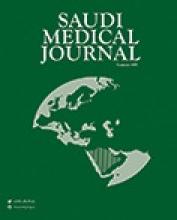Abstract
OBJECTIVES: To study knee angles in the adult Saudi population and compare their values to the published data from other populations.
METHODS: Antero-posterior bilateral radiographs of 333 normal knees of 120 males and 213 females, with age range of 18-65 years, were studied retrospectively at King Khalid University Hospital, King Saud University, Riyadh, Saudi Arabia, from January 2009 to December 2009. Tibiofemoral (TFA), lateral distal femoral (LDFA), and lateral proximal tibial (LPTA) angles were measured and the mean of each angle was calculated. The relationship between each angle and age, gender, and side of the body was tested, and compared with the international figures.
RESULTS: The mean for TFA in Saudis was 174.41°, LDFA was 90.07° and LPTA was 89.42°. All angles were not significantly related to gender. Significant relations existed between TFA and side of the body, and between LDFA and age. Variations in means and ranges of knee angles between the Saudi and other populations were determined. A significant difference existed between means of TFA, LDFA, and LPTA of Saudis and those of Caucasians, between mean of TFA of Saudis and that of Chinese, and between mean of LPTA of Saudi males and that of Chinese males. The means of TFA of selected age groups in Saudis differed significantly when compared to those in the corresponding age groups in Japanese and Australian Caucasians.
CONCLUSIONS: Knee angles are like many other skeletal angles that may have ethnic variation between different populations. The study reinforces the need for reference values of knee angles in a given population.
- Copyright: © Saudi Medical Journal
This is an open-access article distributed under the terms of the Creative Commons Attribution-Noncommercial-Share Alike 3.0 Unported, which permits unrestricted use, distribution, and reproduction in any medium, provided the original work is properly cited.






